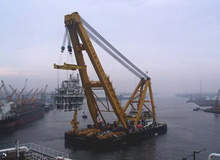
The Blake oil field (Blake ‘Channel’) is a North Sea oil field about 64 miles from Aberdeen (in the Outer Moray Firth). The field began oil production in June 2001, about two months ahead of target.
The field is operated by Talisman Energy (UK) Ltd, a wholly owned subsidiary of Canadian company Talisman Energy Inc, and owned by Talisman (51.99%), Intrepid Energy North Sea Ltd. (13%), Kerr-McGee Resources (UK) Limited (14.49%), Lasmo (ULX) Ltd. (16.33%) and Nippon Oil Expro UK Ltd. (4.19%).
BLAKE OIL FIELD PROJECT
The field, located in blocks 13/24 and 13/29b (discovered in March 1997), is operated by the BG Group and owned by Talisman (53.6%), BG Group (44%) and Paladin Expro Limited (2.4%). The cost of the Blake project was CAN$300m (£145m) and will yield 65,000 barrels a day initially. Production at the oil field is eventually expected to peak at around 85,000 barrels a day.
The hydrocarbons produced from the Blake field are transported via flow lines to a subsea production manifold for onward transportation to the Bleo Holm FPSO (9.5km away) via 10in and 12in production lines. On the FPSO, the Blake fluids are processed with those from the Ross field.
The produced oil, gas and water are separated on the Bleo Holm and the oil temporarily stored onboard prior to export using the shuttle tanker. The surplus gas is exported via the existing Ross tie-in to the 24in Frigg UK pipeline to the St Fergus gas terminal.
BLEO HOLM FLOATING PRODUCTION, STORAGE AND OFFLOADING (FPSO) UNIT
Production from the Ross oil field was suspended in March 2001 to allow onshore topside modifications to the Bleo Holm unit. These modifications were completed and the vessel returned to the field for offshore hook-up ahead of the project schedule, allowing production to resume well ahead of the planned date (and under budget).
The FPSO unit is an ‘Aframax’ tanker hull, specially designed for FPSO duty, with a double bottom and double sides. It has a design life of 20 years and is capable of retaining certificates without leaving the field for a period of at least eight years.
At the front of the unit are the flare boom and the turret mooring system, designed to permanently moor the Bleo Holm at a location in all weather conditions. The anchor leg pattern provides large free sectors in which to install flexible risers and umbilicals. The turret is equipped with J-tubes supporting the risers for liquids and gas and umbilicals for power, controls and chemicals.
Supported on the main deck in large modules is equipment for processing and power generation. A shuttle tanker mooring and offloading system is located at the stern, capable of discharging crude oil into shuttle tankers of up to 150,000 dead-weight tonnage.
FUNCTIONS OF THE BLEO HOLM FPSO IN THE BLAKE OIL FIELD
The main functions of the Bleo Holm are:
- Receipt of fluids from subsea wells
- Control of the subsea wells
- The processing of incoming fluids for separation into crude, water and gas
- Storage of the dry crude oil (and maintaining it at the required temperature)
- Treatment of effluent for discharge of water to the sea
- Chemical injection
- Export of produced gas to the Frigg pipeline (part of the gas is used as fuel)
- Injection of treated seawater into the injection wells
- Offloading crude into ‘tandem moored’ shuttle tankers
- Power generation for process, export of gas, offloading and utilities
- Providing accommodation for operating and maintenance personnel
- Providing a landing area for helicopter operations.
All systems are designed for a minimum annual average uptime of 95%.
LEAD CONTRACTORS
The contract for the tie-in, including engineering, hook-up, installation and commissioning, was awarded to Aker Maritime’s UK yard, Aker McNulty, and was worth £15m-20m. The Bleo Holm is a Floating Production, Storage and Offloading (FSPO) unit designed, built, owned and operated by Bluewater.
The contract for the design, procurement and commissioning of crude separation and water process separation equipment was awarded to Axsia by Fluor Daniel Ltd. The FPSO went into service in 1999 in the Ross oil field, off the coast of Aberdeen in Scotland.
BLAKE FLANK DEVELOPMENT
The Blake Flank development is a smaller developed oil field directly adjacent to the original Blake Channel field (Blake Flank spudded in September 2001 and was approved by the DTI in November 2002).
The first production from Blake Flank was brought online in September 2003 with an estimated flow rate of 5,200 barrels a day. The field is operated by BG Group with a 44% interest and the remainder being held by Talisman Energy (53.6%) and Paladin Resources (2.4%).
The Blake Flank field is tied into the current Blake production pipeline infrastructure thus extending the economic life of the original Blake Channel.
field are transported via flow lines to a subsea production manifold.”
Jon Wormley, BG executive vice president and managing director, UK, said: “The development of Blake Flank was made possible through the efficient use of existing infrastructure. Achieving first production only ten months from project sanction is a tribute to the cooperative working of the Blake partners. Thanks should also go to the contractors and the neighbouring Ross Field Group, who were instrumental in helping complete the tight project deadlines.”
BLAKE FLANK CONTRACTORS
The design, fabrication and installation of the subsea infrastructure including flowlines and umbilicals was undertaken by Technip UK Ltd.
The subsea controls work contract was awarded to Kvaerner Oilfield Products Ltd, with the subsea christmas trees supplied by Cameron Cooper. The drilling operations for Blake Flank were undertaken using the Global Santa Fe semi-submersible rig Glomar Arctic IV.



